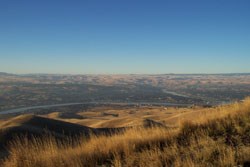
Nez Perce National Historical Park From this overlook one can see a vast expanse of the Nez Perce homeland - the Snake and Clearwater Rivers, Hells Canyon, and, on a clear day, glimpses of the Bitterroot and Wallowa Mountains. The Clearwater River joins the Snake River at Lewiston, continuing to the Columbia 100 miles to the west. The water you see from this spot will eventually drain to the Pacific Ocean. Today, four dams on the Snake River allow barge traffic to come 400 miles up from Portland, Oregon all the way to Lewiston, Idaho. Salmon still migrate up the river to lay their eggs as they have done for centuries, though their numbers are now greatly reduced. The Nez Perce used the Clearwater and its tributaries as a super highway of sorts, traveling up and down the river to visit relatives, trade, and fish. These river basins also had beavers, attracting fur traders on the heels of Lewis and Clark. The Fur Trade Far below the confluence overlook on the north bank of the Clearwater River, Donald MacKenzie established a trading post in August of 1812. It was the first and last time a fur company would attempt to establish a trading post in Nez Perce country. As part of John Jacob Astor's plan to counter the work of the North West and Hudson's Bay Companies, he established an American presence on the Columbia River and in the Rocky Mountains. After a difficult trip through southern Idaho, the expedition split into smaller groups. One, led by MacKenize, went north through the mountains and Hell's Canyon. They encountered some Nez Perce who provided the starving fur traders with food before continuing their journey to Fort Astoria. Since the other trading companies had not established trading posts in the area, MacKenzie thought it would be prudent to establish a presence in the area. While the Nez Perce welcomed the trade goods that MacKenzie had to offer, they were unwilling to catch pelts in exchange for goods. McKenzie made things worse when he accused the Nez Perce of pilfering trade goods from a cache. One of McKenzie's lieutenants, John Clarke, hung a Palouse Indian, accusing him of stealing. Tensions with the Nez Perce and the War of 1812 ended the vision of creating an American Fur Empire. |
Last updated: July 6, 2020
